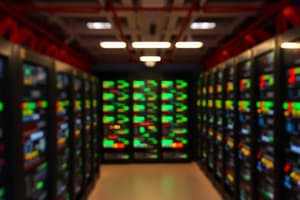Podcast
Questions and Answers
What are some non-conventional/renewable energy sources used for distributed generation?
What are some non-conventional/renewable energy sources used for distributed generation?
natural gas, biogas, wind power, solar photovoltaic cells, fuel cells, combined heat and power (CHP) systems, microturbines, and Stirling engines
What is the term used to describe the integration of distributed energy resources into the utility distribution network?
What is the term used to describe the integration of distributed energy resources into the utility distribution network?
Distributed generation (DG)
What distinguishes distributed generation from centralised conventional generation?
What distinguishes distributed generation from centralised conventional generation?
The term 'Distributed Generation' has been devised to distinguish this concept of generation from centralised conventional generation.
What happens to the distribution network with the integration of distributed generation?
What happens to the distribution network with the integration of distributed generation?
What are some of the problems that have led to the trend of generating power locally at distribution voltage level?
What are some of the problems that have led to the trend of generating power locally at distribution voltage level?
Flashcards are hidden until you start studying
Study Notes
Non-Conventional/Renewable Energy Sources for Distributed Generation
- Solar panels harness sunlight to convert it into electricity, commonly used in residential and commercial applications.
- Wind turbines capture wind energy to generate electricity, suitable for both onshore and offshore sites.
- Biomass energy utilizes organic materials (like agricultural waste) for power production, contributing to waste reduction and energy generation.
- Geothermal energy exploits heat from the Earth’s interior for power and heating applications, mainly in volcanic regions.
- Hydroelectric systems utilize flowing water to generate energy, often implemented in small-scale applications for localized energy needs.
Integration of Distributed Energy Resources
- The term "Distributed Generation" refers to the integration of various decentralized energy sources into the utility distribution network, enhancing local energy supply and resiliency.
- Smart grid technology facilitates this integration by improving communication and control across the energy network.
Differences Between Distributed and Centralized Generation
- Distributed generation systems are smaller, located near the point of use, and use renewable sources, unlike centralized plants that rely on large-scale fossil fuel or nuclear energy.
- Distributed systems provide benefits like reduced transmission losses, improved reliability, and the potential for energy independence.
Impact on Distribution Network
- The integration of distributed generation can lead to a more resilient power grid, capable of handling localized power demands and mitigating outages.
- Distribution networks may require infrastructural upgrades, including energy storage solutions and advanced metering systems, to accommodate bidirectional energy flows.
Problems Leading to Localized Power Generation
- Increasing energy demand and peak load challenges necessitate more localized and flexible energy solutions.
- Aging infrastructure in centralized power systems raises concerns about reliability and the need for modernization.
- Environmental regulations and the push for sustainable energy sources promote the shift toward renewable, locally-generated power.
- Economic factors, such as rising electricity costs and the availability of technology, enable consumers to invest in local generation systems.
Studying That Suits You
Use AI to generate personalized quizzes and flashcards to suit your learning preferences.




